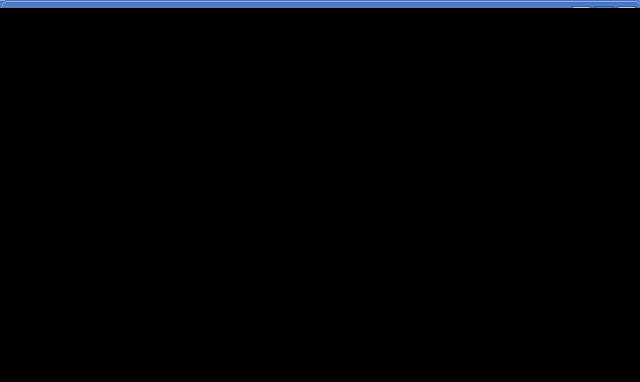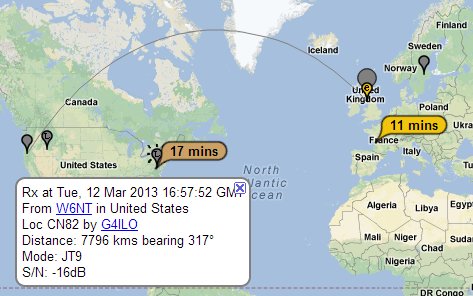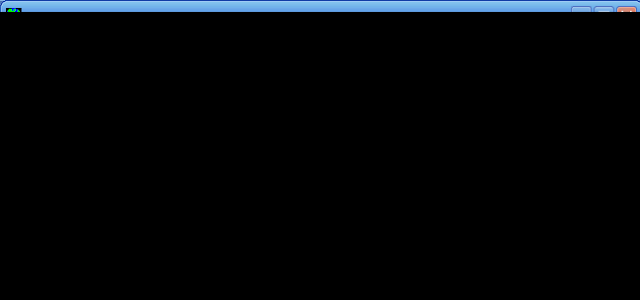Posts Tagged ‘Digimodes’
 JT9-1 with 1W
JT9-1 with 1W
I see that some bloggers have complained that HF propagation today was not too good. My 5W JT9-1 signal on 20m was spotted several times at reasonable strength by VK3AMA so this afternoon I thought I would see how far I could get with 1 watt.
 |
| Reception of JT9-1 signal from G4ILO using 1W to attic dipole |
 Spotted in VK
Spotted in VK
If you get the impression that I’m keen on K1JT’s new JT9-1 mode, you’d be right. This morning my signal (25W to an attic dipole) was spotted by Laurie VK3AKA in Australia – the longest distance I’ve been received using JT9-1 yet. A QSO must surely follow.
My signals down under were -18dB. Yes, it seems Laurie is testing some new add-on for WSJT-X that spots to Hamspots with additional info. Exciting stuff! JT9-1 is turning out to be the WSPR QSO mode that many hoped for.
 A rant about RTTY
A rant about RTTY
I just worked Iraq for the first time. YI1RZ on 20m using JT9-1 mode.
 |
| YI1RZ |
What was remarkable about this QSO is that I worked YI1RZ despite the presence of heavy RTTY QRM. My Elecraft K3 has great filtering but it can do nothing about a RTTY signal that is straddling the QSO frequency.
Why, in this age of DSP, do people persist in using this antiquated mode? Dating from the 1930s and the age of mechanical teleprinters and analog modems, RTTY is by any definition an outmoded mode. It requires far too much power and occupies far too much bandwidth for the data transmission rate (45 baud.) PSK31 has existed for more than a decade and is a far more efficient mode. If PSK31 is too slow then there is PSK63 which is faster than RTTY and yet still manages to occupy less bandwidth. Not to mention the plethora of other modes such as MFSK and Olivia that have been invented in the last 10 years offering far greater reliability than RTTY and, like PSK, the ability to use the entire character set not just capital letters, numbers and a few punctuation symbols. And which don’t print up garbage because a shift character wasn’t decoded.
It feels good to get that off my chest! I’d better put my asbestos suit on! It is interesting to note that as I have been typing this WSJT-X has been pulling JT9-1 out of the air in the teeth of RTTY interference so great that you cannot even see the JT9-1 signal traces. JT9 rocks! I doubt if the RTTY operators even know the JT9-1 signals are there.
 New WSJT-X update
New WSJT-X update
Hot news. I’ve just had an email from Joe Taylor K1JT informing me that a new version of WSJT-X, v0.6 r3045, has just been made available for download from the WSJT home page.
This is a must-have update which now includes spotting of JT9 signals decoded to the PSK Reporter website. (Tip: This needs to be enabled in Settings.)
Still to come are rig control – which I will hazard a guess will use hamlib – and integration with VK3AMA’s JT-Alert. Hopefully this will encourage current users of JT65 on HF to try the new JT9-1 mode which is 2dB more sensitive than JT65A and occupies less than 10% of the bandwidth.
Thanks Joe for giving us these great programs.
 JT on JT9
JT on JT9
I had an all-day session on the JT modes today. Actually, almost all of today’s contacts were on JT65A. I did listen for JT9-1 signals a few times but most of the time I only saw stations I had already worked before.
I put out a CQ call on 15m JT9-1 and Joe Taylor K1JT came back to me. I’ve decoded Joe’s WSPR signals numerous times and I’ve exchanged several emails with him but I had never had a radio contact with him until now, so that was a nice surprise.
Then it was back to JT65A. The contrast in activity was extreme. There were so many stations active I couldn’t find a space to call CQ, so I had to wait and pounce on new stations that called.
I must say that when using JT9 I miss the infrastructure that has been built up around the JT65A mode – the reverse beacons, the auto-spotting to PSK Reporter so you can see how far your signals have got, the JT-Alerts when you decode someone you’ve worked before. I especially need the B4 alerts. My memory is so bad I can’t remember the calls of stations I’ve worked before so I have often called people who I have worked only a couple of days earlier. I guess that due to the lack of new stations they probably don’t mind too much!
 Ghosts on JT9-1
Ghosts on JT9-1
I spent a couple of hours working JT9-1 on 20m this afternoon. I only messed up once when I forgot where I was in the sequence. I could do with the software showing the outgoing message in the log as well.
 WSJT-X update
WSJT-X update
A couple of days ago I had an email from Joe, K1JT, author of the WSPR and WSJT software. He had read my post about my first JT9-1 QSO in which I said that I missed the JT65-HF user interface. Joe pointed out that WSJT-X is in a very early stage of program development, and user input will surely help to define its future evolution. He asked what features of the JT65-HF GUI I found desirable.
I replied with what I thought were the key points that made JT65-HF easier to use. The result is a new version of WSJT-X which I have just tried. One change is that the horizontal ‘panadapter’ display scale now matches the waterfall when the user has set FFT Bins/Pixel greater than 1.
However, the real big change is that double-clicking on a decode line now generates a set of messages addressed to the second callsign on the line, regardless of where you double-click. It also sets the Tx and Rx frequencies to that of the decoded transmission and selects the first message in the sequence. This is a big time and error-saver in the few seconds you have between receiving a call and having to reply. You still have to set Auto to ON to enable the transmitter and select the next message in the sequence after the first has been received. Perhaps it’s a matter of personal preference but I don’t think it is a bad thing for the user to take control of this rather than have the program try to work out the appropriate reply. In other words, double-click on a decode when it is a CQ call or a reply to your CQ. Use the Tx n buttons to select the next message in the sequence as you progress through the QSO.
Try this latest version of WSJT-X. I think you’ll find it a big improvement. Now all we need is for Laurie VK3AMA to come up with a version of JT-Alert that adds logging and ‘worked before’ detection and there will be no reason not to switch to this much narrower JT mode.

















